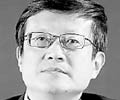Industrial output in August expanded just 6.9 percent year-on-year, the weakest level since the global financial crisis six years ago. Fixed-asset investment, retail sales and the growth of home sales also slowed last month. The numbers underscore the risks of a deepening economic slowdown prompted by a slumping property market. The slowdown will test Premier Li Keqiang's resolve to avoid stronger monetary stimulus to meet the 7.5 percent GDP growth goal this year. Economists are hotly debating whether the government should launch a stimulus package to meet the goal. Several of those economists weigh in here.

Cao Yuanzheng, chief economist with Bank of China Ltd
China's growth rate has apparently fallen to a new floor and is groping for the next lowest level. The problem is whether the economy can hold firm at even the lower floor.
One should not read too much into a single month's data.
An economist should use at least a full quarter of data to draw conclusions.
Many people have argued in favor of a cut in interest rates or banks' reserve requirement ratios to unleash more liquidity into the market to spur growth. But I do not think that would help much, as demand for credit is weak, given the sluggish growth momentum and severe overcapacity.
Despite low industrial output growth in August, it is unlikely that full-year GDP growth will slip below 7 percent.
First-half GDP growth hit 7.4 percent, and in most years, fourth-quarter growth rebounds from the third quarter.
What is more, the annual target for job creation was almost reached during the first eight months.

Lian Ping, chief economist at Bank of Communications Co Ltd
Although market participants generally believe that China should lower lending rates and cut the reserve requirement ratios for all banks, the authorities do not think this is the best time to do so. Officials believe that such steps are unnecessary in the short term, because the economy is still maintaining a reasonable range of growth.
Instead, China will continue fine-tuning monetary and fiscal policies. The government will also accelerate the enforcement of relevant policies that were launched during the first half of this year.
To lower lending rates and reduce corporate financing costs, the authorities must remove the barriers that keep money from flowing into the real economy at lower costs. The banking regulator must change outdated rules and procedures, because huge changes have taken place in the financial market. For instance, it should ease stringent rules on banks' loan-to-deposit ratios.
If the authorities do not increase liquidity, even two lending rate cuts of 25 basis points each will not have much impact on borrowing costs.

Ma Guangyuan, economist and commentator for China Central Television
Despite Premier Li Keqiang's repeated pledge that strong stimulus measures will not be rolled out, foreign and domestic financial institutions, as well as local governments, are pushing hard for just such a step. This behavior reflects habits of thought and an insufficient understanding of the economic cycle. But it is also happening because these parties doubt the government's resolve to pursue reform. In the past, government "paternalism" emerged every time the economic indicators fluctuated. That has led to a "deep reliance" on stimulus and an ingrained way of thinking ...The tool of "strong stimulus" should be removed from macroeconomic policy for good.

Wang Tao, chief economist of UBS China
Premier Li Keqiang said at the recent Summer Davos meeting that the government will rely more on targeted easing and reforms rather than strong fiscal and monetary stimulus to support growth, noting that this year's job creation target has already been almost fulfilled. Nevertheless, weak industrial production growth in August and an expected further slowdown in infrastructure construction will test the government's policy resolve. We expect additional policy support ... in the coming months, including a possible cut in interest rates ... A cut in the benchmark lending rate is also the most direct and effective way to lower financing costs in the economy as nearly 70 percent of credit is priced off of the benchmark. That said, we think a cut in mortgage lending rates may more likely come first.

Qu Hongbin, chief China economist at HSBC Holdings Plc
The Chinese authorities should not underestimate the downward pressure on the economy or let that pressure continue to grow. The central bank should conduct its monetary policy more flexibly and fine-tune policy to help companies get through the hard times.
The real economy keeps slowing, even though the central bank has been taking mini-stimulus measures since 2012. I suggest that the authorities combine mini-stimulus measures with medium-term economic development targets such as urbanization to combine the fragmented, temporary mini-stimulus measures into a more systemic, continuous policy.
The majority of domestic companies are complaining about high financing costs. There are two ways to reduce those costs. One is to lower lending rates. The other is to use targeted monetary policy tools such as pledged supplementary lending to inject liquidity into the market. I prefer lowering the lending rates by all banks nationwide, which is a simple and direct policy. Tools such as PSL actually make the problem more complicated.

Shen Jianguang, Mizuho Securities Asia Ltd
This is probably a wake-up call. I do not think the central government officials will take a general stimulus approach because they already said they will be using targeted measures. I think a targeted cut in mortgage rates would be the next step. This would have a positive effect on the economy, for first-and second-time buyers. That could be very helpful for the economy. Other measures would be much slower to materialize. They have to move. If we have no pickup in real-estate sales in September, it could be very bad. Then property developers will slash investment and it will become even worse. They have to introduce more stimulus, otherwise how can they even achieve 7.3 percent growth?
